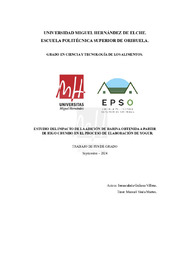Please use this identifier to cite or link to this item:
https://hdl.handle.net/11000/33548Full metadata record
| DC Field | Value | Language |
|---|---|---|
| dc.contributor.advisor | Viuda-Martos, Manuel | - |
| dc.contributor.author | Galiana Villena, Inmaculada | - |
| dc.contributor.other | Departamentos de la UMH::Tecnología Agroalimentaria | es_ES |
| dc.date.accessioned | 2024-10-18T10:42:36Z | - |
| dc.date.available | 2024-10-18T10:42:36Z | - |
| dc.date.created | 2024-09 | - |
| dc.identifier.uri | https://hdl.handle.net/11000/33548 | - |
| dc.description.abstract | En este trabajo se aplicó harina obtenida a partir de higo chumbo (Opuntia -Ficus), a un lácteo de tipo yogurt a fin de evaluar el efecto de la adición de harinas obtenidas de la piel y la pulpa del higo chumbo, Opuntia ficus-indica, sobre las propiedades fisicoquímicas y sensoriales de un yogur elaborado con leche de oveja, obteniendo tres formulaciones diferentes donde variaba el tipo de harina adicionada. La incorporación de harina obtenida a partir de higo chumbo modificó algunas características del yogur. A nivel fisicoquímico, se observó un acortamiento del tiempo de fermentación, (hasta llegar a pH 4,6) y un cambio en la coloración, predominando tonos rojizos, amarillosos y más oscuros. En la evaluación sensorial, el yogur con harina de piel destacó por su textura y aroma, mientras que el yogur control fue valorado también positivamente por su color y sabor, al contrario de la muestra con adición de harina de pulpa de higo chumbo. El consumo del higo chumbo es más habitual en América del Sur que en España, no obstante, su tratamiento por desecado y molienda, lo convierte en una harina con diversas ventajas tecnológicas, ya que esta puede tener función de sustituyente de grasas, mejora de calidad, textura o viscosidad, gracias a su riqueza en fibra. Asimismo, puede tener función de prebiótico. A nivel medioambiental, la elaboración de harinas a partir de subproductos de frutas podría fomentar una economía circular, otorgando un nuevo valor a los residuos y minimizando el desperdicio alimentario. | es_ES |
| dc.description.abstract | In this study we have researched the effect of prickly pear (Opuntia ficus-indica) on sheep milk yogurts. Flour made from the pulp and the peel of the fruit was added to the yogurts, to measure physiochemical and sensorial properties. We obtained three formulations with different flours of the different parts of the fruit. The incorporation of the prickly pear flour modified some yogurt characteristics. At a physiochemical level, a reduction in the fermentation time - pH 4,6 -, and a change in colour, with a predominance of red, yellow and darker tones, were observed. In the sensory evaluation, the yogurt with peel flour stood out by it scent and texture, while the control yogurt was evaluated positively by its color and taste, quite opposite to the sample with prickly pear pulp. The prickly pear consumption is more common in South America than in Spain; however, its treatment by dehydration, and milling, transforms it into a flour with great technological advantages. This flour offers functions of fat substitution, and quality, texture and viscosity enhancement, thanks to its richness in fiber, furthermore, it may also have prebiotics functions. At an environmental level, the elaboration of flour from fruit subproducts can promote the circular economy, giving new value to diverse products and minimizing food waste. | es_ES |
| dc.format | application/pdf | es_ES |
| dc.format.extent | 51 | es_ES |
| dc.language.iso | spa | es_ES |
| dc.publisher | Universidad Miguel Hernández de Elche | es_ES |
| dc.rights | info:eu-repo/semantics/openAccess | es_ES |
| dc.rights.uri | http://creativecommons.org/licenses/by-nc-nd/4.0/ | * |
| dc.subject | Harina | es_ES |
| dc.subject | Higo Chumbo | es_ES |
| dc.subject.other | CDU::6 - Ciencias aplicadas::66 - Ingeniería, tecnología e industria química. Metalurgia::663/664 - Alimentos y nutrición. Enología. Aceites. Grasas | es_ES |
| dc.title | Estudio del impacto de la adición de harina obtenida a partir de higo chumbo en el proceso de elaboración de yogur | es_ES |
| dc.type | info:eu-repo/semantics/bachelorThesis | es_ES |

View/Open:
TFG GALIANA VILLENA, MARIA INMACULADA.pdf
5,95 MB
Adobe PDF
Share:
.png)
